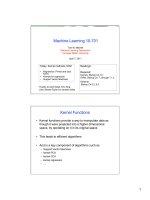support vector and kernel methods for pattern recognition
Bạn đang xem bản rút gọn của tài liệu. Xem và tải ngay bản đầy đủ của tài liệu tại đây (566.37 KB, 69 trang )
1
Support Vector and Kernel
Methods
for Pattern Recognition
www.support-vector.net
A Little History
! Support Vector Machines (SVM) introduced in COLT-
92 (conference on learning theory) greatly developed
since then.
! Result: a class of algorithms for Pattern Recognition
(Kernel Machines)
! Now: a large and diverse community, from machine
learning, optimization, statistics, neural networks,
functional analysis, etc. etc
! Centralized website: www.kernel-machines.org
! Textbook (2000): see www.support-vector.net
2
www.support-vector.net
Basic Idea
! Kernel Methods work
by embedding the data
into a vector space,
and by detecting linear
relations in that space
! Convex Optimization,
Statistical Learning
Theory, Functional
Analysis are the main
tools
www.support-vector.net
Basic Idea
! “Linear relations”:
can be regressions,
classifications,
correlations,
principal
components, etc.
! If the feature space
chosen suitably,
pattern recognition
can be easy
3
www.support-vector.net
General Structure
of Kernel-Based Algorithms
! Two
Separate
Modules:
Learning
Module
Kernel
Function
A learning algorithm:
performs the learning
In the embedding space
A kernel function: takes
care of the embedding
www.support-vector.net
Overview of the Tutorial
! Introduce basic concepts with
extended example of Kernel
Perceptron
! Derive Support Vector Machines
! Other kernel based algorithms
(PCA;regression; clustering;…)
! Bioinformatics Applications
4
www.support-vector.net
Just in case …
! Inner product between vectors
! Hyperplane:
xz xz
ii
i
,
=
∑
x
x
o
o
o x
x
o
o
o
x
x
x
w
b
wx b, +=0
www.support-vector.net
Preview
! Kernel methods exploit information about
the inner products between data items
! Many standard algorithms can be rewritten
so that they only require inner products
between data (inputs)
! Kernel functions = inner products in some
feature space (potentially very complex)
! If kernel given, no need to specify what
features of the data are being used
5
www.support-vector.net
Basic Notation
! Input space
! Output space
! Hypothesis
! Real-valued:
! Training Set
! Test error
! Dot product
x
X
yY
hH
fX
Sxy xy
xz
ii
∈
∈=−+
∈
→
=
{,}
:R
{( , ), ,( , ), }
,
11
11
ε
www.support-vector.net
Basic Example:
the Kernel-Perceptron
! We will introduce the main ideas of
this approach by using an example:
the simplest algorithm with the
simplest kernel
! Then we will generalize to general
algorithms and general kernels
6
www.support-vector.net
Perceptron
! Simplest case: classification. Decision
function is a hyperplane in input
space
! The Perceptron Algorithm
(Rosenblatt, 57)
! Useful to analyze the Perceptron
algorithm, before looking at SVMs
and Kernel Methods in general
www.support-vector.net
Perceptron
! Linear Separation
of the input space
x
x
o
o
o x
x
o
o
o
x
x
x
w
b
fx wx b
hx signfx
() ,
() (())
=+
=
7
www.support-vector.net
Perceptron Algorithm
Update rule
(ignoring
threshold):
! if
then
ywx
iki
(,)≤ 0
wwyx
kk
kkii+
←+
←+
1
1
η
www.support-vector.net
Observations
!Solution is a linear combination of
training points
!Only used informative points (mistake
driven)
!The coefficient of a point in
combination reflects its ‘difficulty’
wyx
iii
i
=
≥
∑
α
α
0
8
www.support-vector.net
Observations - 2
! Mistake bound:
! coefficients are non-
negative
! possible to rewrite the
algorithm using this
alternative
representation
x
x
o
o
o
x
x
o
o
o
x
x
x
g
2
≤
γ
R
M
www.support-vector.net
Dual Representation
The decision function can be re-written
as follows:
fx wx b yxx b
ii i
() , ,
=
+
=
+
∑
α
wyx
iii
=
∑
α
IMPORTANT
CONCEPT
9
www.support-vector.net
Dual Representation
! And also the update
rule can be rewritten as
follows:
! If
then
! Note: in dual
representation, data
appears only inside dot
products
α
α
η
ii
←+
∑
≤+
j
ijjji
bxxyy 0,
α
www.support-vector.net
Duality: First Property of SVMs
!DUALITY is the first feature of Support
Vector Machines (and KM in general)
!SVMs are Linear Learning Machines
represented in a dual fashion
!Data appear only within dot products
(in decision function and in training
algorithm)
fx wx b yxx b
ii i
() , ,
=
+
=
+
∑
α
10
www.support-vector.net
Limitations of Perceptron
!Only linear separations
!Only defined on vectorial data
!Only converges for linearly separable
data
www.support-vector.net
x
x
x
x
o
o
o
o
f(o)
f (x)
f (x)
f(o)
f(o)
f(o)
f (x)
f (x)
f
X
F
Learning in the Feature Space
!Map data into a feature space where
they are linearly separable
x
x
→
φ
()
11
www.support-vector.net
Trick
!Often very high dimensional spaces
are needed
!We can save computation by not
explicitly mapping the data to feature
space, but just working out the inner
product in that space
!We will call this implicit mapping
!(many algorithms only need this
information to work)
www.support-vector.net
Kernel-Induced Feature Spaces
!In the dual representation, the data
points only appear inside dot
products:
!The dimensionality of space F not
necessarily important. May not even
know the map
fx y x x b
ii i
() ( ,()
)
=
+
∑
α
φ
φ
φ
12
www.support-vector.net
Kernels
!A function that returns the value of
the dot product between the images of
the two arguments
!Given a function K, it is possible to
verify that it is a kernel
Kx x x x(, ) (),()
12 1 2
=
φ
φ
IMPORTANT
CONCEPT
www.support-vector.net
Kernels
!One can use LLMs in a feature space
by simply rewriting it in dual
representation and replacing dot
products with kernels:
xx Kxx x x12 12 1 2,(,)(),()←=
φ
φ
13
www.support-vector.net
Example: Polynomial Kernels
x
x
x
zzz
xz xz xz
xz xz xzxz
xx xx zz zz
xz
=
=
=+ =
=++ =
==
=
(, );
(, );
,( )
(,, ),(,, )
(),()
12
12
2
11 22
2
1
2
1
2
2
2
2
2
11 22
1
2
2
2
12
1
2
2
2
12
2
22
φφ
www.support-vector.net
Example: Polynomial Kernels
14
www.support-vector.net
The Kernel Matrix
! (aka the Gram matrix):
K(m,m)…K(m,3)K(m,2)K(m,1
)
……………
K(2,m)…K(2,3)K(2,2)K(2,1)
K(1,m)…K(1,3)K(1,2)K(1,1)
IMPORTANT
CONCEPT
K=
www.support-vector.net
The Kernel Matrix
! The central structure in kernel
machines
! Information ‘bottleneck’: contains all
necessary information for the learning
algorithm
! Fuses information about the data AND
the kernel
! Many interesting properties:
15
www.support-vector.net
Mercer’s Theorem
! The kernel matrix is Symmetric
Positive Definite
(has positive eigenvalues)
! Any symmetric positive definite
matrix can be regarded as a kernel
matrix, that is as an inner product
matrix in some space
www.support-vector.net
Mercer’s Theorem
! Eigenvalues expansion
of Mercer’s Kernels:
! The features are the
eigenfunctions of the
integral operator
Kx x x x
i
i
ii
(, ) ()()
12 1 2
=
∑
λφ φ
∫
=
X
dxxfxxKxTf ')'()',())((
16
www.support-vector.net
Examples of Kernels
! Simple examples of kernels are:
Kxz xz
Kxz e
d
xz
(,) ,
(,)
/
=
=
−−
2
2
σ
www.support-vector.net
Example: the two spirals
! Separated by a
hyperplane in
feature space
(gaussian kernels)
17
www.support-vector.net
Making kernels
!From kernels (see closure properties):
can obtain complex kernels by
combining simpler ones according to
specific rules
www.support-vector.net
Closure properties
! List of closure
properties:
if K
1
and K
2
are
kernels, and c>o
! Then also K is a kernel
)()(),(
:
),(),(),(
),(),(),(
),(),(
),(),(
21
21
1
1
zfxfzxK
Xf
zxKzxKzxK
zxKzxKzxK
zxKczxK
zxKczxK
⋅=
ℜ→∀
⋅=
+=
+=
⋅=
18
www.support-vector.net
Some Practical Consequences
! if K1 and K2 are
kernels, and c>o
d>0 integer
! Then also K is a
kernel
),(),(
),(
),(
2
),(2),(),(
exp),(
),(
exp),(
)),((),(
11
1
2
111
2
1
1
zzKxxK
zxK
zxK
zxKzzKxxK
zxK
zxK
zxK
czxKzxK
d
=
−+
−=
=
+=
σ
σ
www.support-vector.net
Making kernels
!From features:
start from the features, then obtain
the kernel.
Example: the polynomial kernel, the
string kernel, …
19
www.support-vector.net
Learning Kernels
!From data:
!either adapting parameters in a
parametric family
!or modifying the kernel matrix (as
seen below)
!Or training a generative model, then
extract kernel as described before
www.support-vector.net
Second Property of SVMs:
SVMs are Linear Learning Machines,
that
! Use a dual representation
AND
! Operate in a kernel induced feature
space
(that is:
is a linear function in the feature space
implicitely defined by K)
fx y x x b
ii i
() ( ,()
)
=+
∑
αφ φ
20
www.support-vector.net
Kernels over General Structures
! Haussler, Watkins, etc: kernels over
sets, over sequences, over trees, etc.
! Applied in text categorization,
bioinformatics, etc
www.support-vector.net
A bad kernel …
! … would be a kernel whose kernel
matrix is mostly diagonal: all points
orthogonal to each other, no clusters,
no structure …
1…000
……………
1
0…010
0…001
21
www.support-vector.net
No Free Kernel
! If mapping in a space with too many
irrelevant features, kernel matrix
becomes diagonal
! Need some prior knowledge of target
so choose a good kernel
IMPORTANT
CONCEPT
www.support-vector.net
Other Kernel-based algorithms
! Note: other algorithms can use
kernels, not just LLMs (e.g.
clustering; PCA; etc). Dual
representation often possible (in
optimization problems, by
Representer’s theorem).
22
www.support-vector.net
www.support-vector.net
The Generalization Problem
! The curse of dimensionality: easy to overfit
in high dimensional spaces
(=regularities could be found in the training set that
are accidental, that is that would not be found again
in a test set)
! The SVM problem is ill posed (finding one
hyperplane that separates the data: many
such hyperplanes exist)
! Need principled way to choose the best
possible hyperplane
NEW
TOPIC
23
www.support-vector.net
The Generalization Problem
! Many methods exist to choose a good
hyperplane (inductive principles)
! Bayes, statistical learning theory /
pac, MDL, …
! Each can be used, we will focus on a
simple case motivated by statistical
learning theory (will give the basic
SVM)
www.support-vector.net
Statistical (Computational)
Learning Theory
! Generalization bounds on the risk of
overfitting (in a p.a.c. setting:
assumption of I.I.d. data; etc)
! Standard bounds from VC theory give
upper and lower bound proportional
to VC dimension
! VC dimension of LLMs proportional to
dimension of space (can be huge)
24
www.support-vector.net
Assumptions and Definitions
! distribution D over input space X
! train and test points drawn randomly
(I.I.d.) from D
! training error of h: fraction of points in S
misclassifed by h
! test error of h: probability under D to
misclassify a point x
! VC dimension: size of largest subset of X
shattered by H (every dichotomy
implemented)
www.support-vector.net
VC Bounds
=
m
VC
O
~
ε
VC = (number of dimensions of X) +1
Typically VC >> m, so not useful
Does not tell us which hyperplane to choose
25
www.support-vector.net
Margin Based Bounds
f
xfy
m
R
O
ii
i
)(
min
)/(
~
2
=
=
γ
γ
ε
Note: also compression bounds exist; and online bounds.
www.support-vector.net
Margin Based Bounds
! (The worst case bound still holds, but if
lucky (margin is large)) the other bound
can be applied and better generalization
can be achieved:
! Best hyperplane: the maximal margin one
! Margin is large is kernel chosen well
=
m
R
O
2
)/(
~
γ
ε
IMPORTANT
CONCEPT









